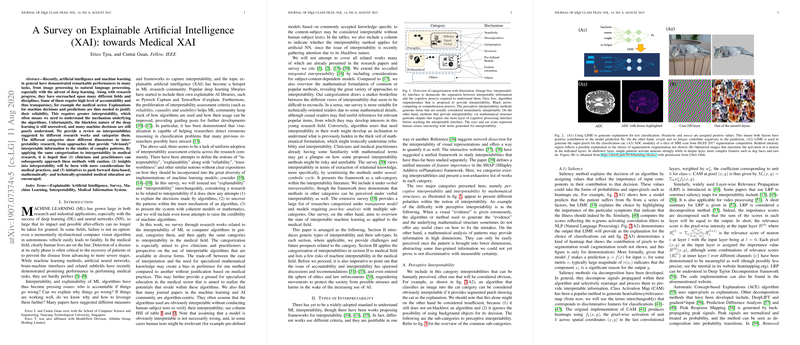A Survey on Explainable Artificial Intelligence (XAI): towards Medical XAI
The paper "A Survey on Explainable Artificial Intelligence (XAI): towards Medical XAI" by Erico Tjoa and Cuntai Guan provides an extensive review of the current state of explainable artificial intelligence (XAI) with a specific concentration on its application within the medical field. It discusses various approaches to interpretability, categorizes them, and evaluates their potential and limitations, especially concerning medical applications.
Overview of Interpretability Approaches
The paper categorizes interpretability methods into two broad categories: Perceptive Interpretability and Interpretability via Mathematical Structures.
Perceptive Interpretability includes methods that are easily perceived by human senses. Saliency methods such as Layer-wise Relevance Propagation (LRP), Grad-CAM, and techniques like Local Interpretable Model-agnostic Explanations (LIME) fall into this category. These methods use various mechanisms like decomposition and sensitivity analysis to highlight the contributions of different input components to the model's predictions. They often provide visual explanations in the form of heatmaps or textual explanations like logical statements.
Interpretability via Mathematical Structures focuses on more abstract and theoretically grounded approaches. These include linear models, Generalized Additive Models (GAM), and clustering or dimensionality reduction techniques like PCA and t-SNE. These methods rely on extracting and analyzing structured patterns and correlations from the data which can be mathematically interpreted to understand the model’s behavior.
Key Findings and Applications in the Medical Field
The paper extends these categories to the medical field, highlighting the necessity for transparency and accountability when dealing with medical data and decisions. Due to the high stakes involved, interpretability in medical AI is not just a desirable feature but a critical requirement.
Applications and Methodological Advances
The application of saliency methods in medical imaging, such as using Grad-CAM for identifying pleural effusion in chest X-rays or applying LRP to fMRI data, demonstrates the potential of these techniques in clinical settings. These methods provide visual cues that help medical practitioners understand why a certain diagnosis was made by the AI model.
When it comes to predefined models, the use of kinetic modeling for cerebral blood flow in MRI images exemplifies how integrating domain-specific knowledge can enhance interpretability. These models benefit from being grounded in well-understood physiological processes, thereby making their outcomes more trustable and easier to explain.
Constraints and Challenges
The survey identifies several challenges and future prospects in XAI:
- Local versus Global Explanations: There is often a tension between the need for local explanations (for specific predictions) and global explanations (for the overall model behavior). Methods like TCAV attempt to bridge this gap by providing concept-based explanations.
- Robustness and Reliability: Many of the current interpretability methods are sensitive to small changes in input data. For example, adversarial noise can significantly alter the interpretability outputs, which raises concerns about their reliability in medical applications.
- Data Quality and Bias: Medical data often involve noise and biases, which can adversely affect both the model's predictions and its interpretability. High-quality, unbiased datasets are crucial for developing reliable XAI methods.
Implications and Future Directions
The paper suggests several implications for both practical and theoretical development in XAI:
- Human-AI Interaction: Empowering medical practitioners with interpretable AI tools can significantly enhance decision-making processes. However, human supervision remains essential to verify and complement AI decisions, especially in critical medical diagnoses.
- Specialized Education: There is a need for specialized education that integrates medical knowledge, data science, and applied mathematics to bridge the gap between AI developers and medical practitioners.
- Robust Evaluation: Future research should focus more on comparative studies between different interpretability methods, emphasizing their practical utility in medical contexts. The establishment of standardized evaluation frameworks could facilitate this process.
Conclusion
This comprehensive survey underscores the critical role of interpretability in adopting AI within the medical sector. While promising techniques exist, their deployment must be coupled with rigorous evaluation and human oversight to ensure they meet the high standards required in medical practice. Future research and interdisciplinary collaboration will be key to advancing the field of medical XAI and ensuring its safe and effective integration into healthcare systems.
